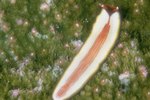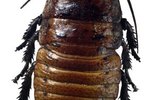
Insects are a diverse class of animal. Some fly, others swim, some are predators, and some survive by eating the feces of other creatures. Insects exist on every continent on Earth and have adapted to their surroundings in each case. One of the many ways insects defend themselves from becoming prey is to come out at night, when their predators are sleeping. For that reason, a number of insects have adapted to feeding only at night.
Nocturnal Light Lovers
Moths are synonymous with the night, yet they are attracted to light. They are relatives of butterflies, but moths exhibit a number of key distinctions directly related to their nocturnal feeding habits. One notable example is that without heat from the sun, moths use their own muscle movement for thermal regulation. Like butterflies, moths feed on pollen and play a key part in the pollination process essential for biodiversity.
Well-Adapted Eyes
Bees are most typically daytime feeders, but some species have evolved to hunt in darkness. One key adaptation of nocturnal feeding bees, such as Indian carpenter bees (Xylocopa tranquebarica), is their compound eyes. The eyes have multiple lenses, enabling the bees to see clearly despite the absence of light. Like moths, nocturnal bees feed on pollen.
Horrifying Nighttime Hunter
It may be for the best that some gruesome and quite terrifying creatures only come out at night. The giant centipede (Ethmostigmus rubripes), native to Australia, is a solitary, elusive and nocturnal hunter. The venomous creature hunts other insects, snails and worms in the shadows of the darkness.
Star Navigators
Like the Indian carpenter bee, dung beetles (Scarabaeoidea) have compound eyes, enabling them to see at night. In fact, dung beetles can only feed at night because they rely on starlight for navigation. Dung beetles are noted for their ability to orientate themselves based on stars in the sky -- it's a crucial adaptation for a creature who feeds by grabbing dung and rolling it to privacy as quickly possible to avoid competition.
Deadly Vectors of Disease
Mosquitoes are responsible for more human deaths than any other animal on the planet. In 2010, around 660,000 human deaths were attributed to mosquitoes. These tiny flying insects are vectors of malaria and West Nile virus. They infect humans by biting them to suck blood, the process of which introduces a deadly parasite into the bloodstream. Mosquitoes are active throughout the day but feed only at night.
Glowing With Efficiency
Fireflies (Lampyridae) are beetles with the distinctive ability to generate light. They waste no energy through heat or movement in light production. They use light to communicate with each other. Attempting to do this in daylight would render their efforts invisible. Fireflies are completely nocturnal, meaning they do everything at night, including feeding on plant pollen and nectar. Firefly larvae glow, too. These are called glowworms.
Nocturnal Soundtrack Makers
The sound of crickets denotes night like nothing else. Many varieties of cricket are active during the day, although the leaf-rolling cricket varieties are nocturnal. These crickets do not have the ability to jump -- crickets' only reliable escape technique when predators appear -- so instead they rely on the cover of darkness to avoid predation.
References
- Pollinator: Like a Moth to a Flower
- Science Daily: Nocturnal Vision of Insects Inspires Automakers to Develop Improved Night Cameras
- Current Biology: Nocturnal Bees Learn Landmark Colors in Starlight
- Australian Museum: Giant Centipede
- Science News: Dung Beetles Steer by the Milky Way
- World Health Organization: Malaria
- PubMed: Nocturnal Activity of Mosquitoes in a West Nile Focus in Connecticut
- Firefly: Facts About Fireflies
- Animal Planet: Crickets
Photo Credits
-
Jupiterimages/Photos.com/Getty Images
Writer Bio
Simon Foden has been a freelance writer and editor since 1999. He began his writing career after graduating with a Bachelors of Arts degree in music from Salford University. He has contributed to and written for various magazines including "K9 Magazine" and "Pet Friendly Magazine." He has also written for Dogmagazine.net.




